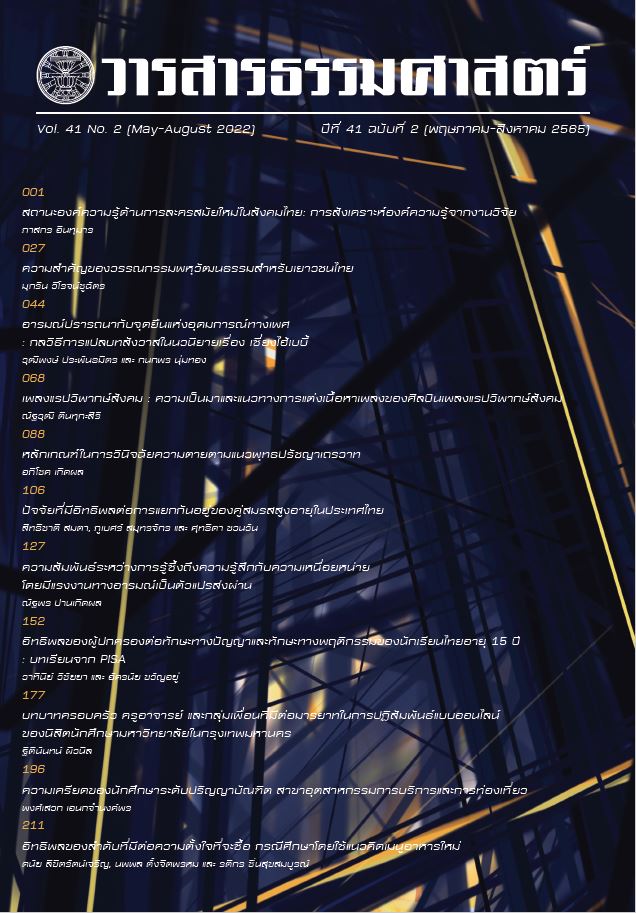Factors Influencing Older Married Couples to Live Apart in Thailand
Main Article Content
Abstract
The objective of this study is to investigate factors influencing the living arrangements of married older couples who live apart from, and with their spouse. Living arrangements of married older persons concern the economic, health, and mental dependence between partners. This study employs a quantitative approach applying a series of statistical techniques, i.e., the chi-square test and binary logistics regression on the Elderly Survey 2017, a nationally representative dataset of 26,077 samples by the Thailand National Statistical Office. The results show that gender, education, residential area, living with children in the same household, having a child living nearby, and work status influenced the living apart married older couples. The results revealed that older women with a high school education or higher and living in municipal areas tended to live apart from their spouses despite of married status. Also, being currently unemployed and having children living nearby influence the married older couples to live apart from their children. Suggestions for policy consideration include the extension of the retirement age will help married older couples living apart from spouses to continue being independent and able to support their spouses. In addition, policies for surveillance and care for a married older person living apart from spouse and alone should be established. Furthermore, tax-deductible measures for children taking care of older parents should take living arrangements into consideration for rate differentiation.
Article Details
References
กองทุนประชากรแห่งสหประชาชาติประจำประเทศไทย. (2558). รายงานสถานการณ์ประชากรไทย พ.ศ. 2558 โฉมหน้าครอบครัวไทย ยุคเกิดน้อย อายุยืน. กรุงเทพฯ : สำนักพิมพ์กองทุนประชากรแห่งสหประชาชาติประจำประเทศไทย.
ศุทธิดา ชวนวัน และคณะ. (2563). รูปแบบการอยู่อาศัยของผู้สูงอายุไทยในเขตเมือง เพื่อสนับสนุนการมีที่อยู่อาศัยและการดูแลที่เหมาะสม (รายงานวิจัยฉบับสมบูรณ์). กรุงเทพฯ : มูลนิธิสถาบันวิจัยและพัฒนาผู้สูงอายุไทย.
สำนักงานสถิติแห่งชาติ. (2554). สรุปสำหรับผู้บริหารการสำรวจสุขภาพจิตกับประชากรสูงอายุในประเทศไทย พ.ศ. 2554. กรุงเทพฯ: สำนักงานสถิติแห่งชาติ.
สำนักงานสถิติแห่งชาติ. (2560). การสำรวจประชากรสูงอายุในประเทศไทย พ.ศ.2560. กรุงเทพฯ: สำนักงานสถิติแห่งชาติ.
Broese van Groenou, M., te Riele, S., & de Jong Gierveld, J. (2019). Receiving Support and Care in Older Age: Comparing LAT Relationships with First Marriages, Remarriages, and Cohabitation. Journal of Family Issues, 40(13), 1786–1807.
Carter, B., & McGoldrick, M. (Eds.). (1989). The changing family life cycle: A framework for family therapy (2nd ed.). Boston, MA: Ally and Bacon.
Castro-Martin, T., Domínguez-Folgueras, M., & Martín-García, T. (2008). Not truly partnerless: Non-residential partnerships and retreat from marriage in Spain. Demographic Research, 18, 443–468.
Coulter, R., & Hu, Y. (2017). Living apart together and cohabitation intentions in Great Britain. Journal of Family Issues, 38, 1701–1729.
De Jong Gierveld, J. (2004). Remarriage, unmarried cohabitation, living apart together: Partner relationships following bereavement or divorce. Journal of Marriage and Family, 66, 236–243.
Elder, G. H., Johnson, M. K., & Crosnoe, R. (2003). The Emergence and Development of Life Course Theory. In Handbook of Social Movements across Latin America (pp. 3–19). Handbook of Social Movements across Latin America.
Haskey J. (2005). Living arrangements in contemporary Britain: having a partner who usually lives elsewhere and living apart together (LAT). Population trends, (122), 35–45.
Haskey, J., & Lewis, J. (2006). Living apart together in Britain: Context and meaning. International Journal of Law in Context, 2, 37–48.
Karlsson, S. G., & Borell, K. (2002). Intimacy and autonomy, gender and ageing: Living apart together. Ageing International, 27(4), 11-26.
Knodel J., Prachuabmoh V., and Chayovan N. (2011). The Changing Well-being of Thai Elderly: An update from the 2011 Survey of Older Persons in Thailand. Chiang Mai: HelpAge International.
Lei, X., Strauss, J., Tian, M., & Zhao, Y. (2015). Living arrangements of the elderly in China: evidence from the CHARLS national baseline. China Economic Journal, 8(3), 191–214.
Lewin, A. C. (2017). Intentions to live together among couples living apart: Differences by age and gender. European Journal of Population, 34(5), 721-743.
McCarthy, J. R., and Edwards, R. (2011). Key concepts in family studies: Family Life Cycle and Life Course. London: SAGE.
Idler, E. L. and Y. Benyamini. (1997, March). Self-rated Health and Mortality: A Review of Twenty-seven Community Studies. Journal of Health & Social Behavior. 38(1): 21-37.
Reimondos, A., Evans, A., & Gray, E. (2011). Living-apart-together (LAT) relationships in Australia: An overview. Family Matters, 87, 43–55.
Regnier-Loilier, A., Beaujouan, É, & Villeneuve-Gokalp, C. (2009). Neither single, nor in a couple. a study of living APART together in France. Demographic Research, 21, 75-108.
Régnier-Loilier, A., & Vignoli, D. (2018). The diverse nature of living apart together relationships: an Italy–France comparison. Journal of Population Research, 35(1), 1–22.
Pothisiri, W., & Quashie, N. T. (2018). Preparations for Old Age and Well-Being in Later Life in Thailand: Gender Matters?. Journal of Applied Gerontology. 37(6): 783-810.
Samanta, T., Chen, F., & Vanneman, R. (2015). Living Arrangements and Health of Older Adults in India. Journals of Gerontology - Series B Psychological Sciences and Social Sciences, 70(6), 937-947.
Sereny, M. D., & Gu, D. (2011). Living Arrangement Concordance and its Association with Self-Rated Health Among Institutionalized and Community-Residing Older Adults in China. Journal of Cross-Cultural Gerontology, 26(3), 239-259.
Sereny, M. (2011). Living Arrangements of Older Adults in China: The Interplay Among Preferences, Realities, and Health. Research on Aging, 33(2), 172–204.
Teerawichitchainan, B., Knodel, J., & Pothisiri, W. (2015). What does living alone really mean forolder persons? A comparative study of Myanmar, Vietnam, and Thailand. Demographic Research, S15(48), 1329-1360.
Turunen, J., Fransson, E., & Bergström, M. (2017). Self-esteem in children in joint physical custody and other living arrangements. Public Health, 149, 106–112.
Upton-Davis, K. (2012). Living Apart Together Relationships (LAT): Severing intimacy from obligation. Gender Issues, 29(1), 25–38.
Yu, C. Y., Hou, S. I., & Miller, J. (2018). Health for older adults: The role of social capital and leisure-time physical activity by living arrangements. Journal of Physical Activity and Health, 15(2), 150-158.
Zhou, Z., Cai, L., Zhuang, M., Hong, Y. A., & Fang, Y. (2019). A longitudinal analysis of the association between the living arrangements and psychological well-being of older Chinese adults: the role of income sources. BMC Geriatrics, 19(1), 347.

